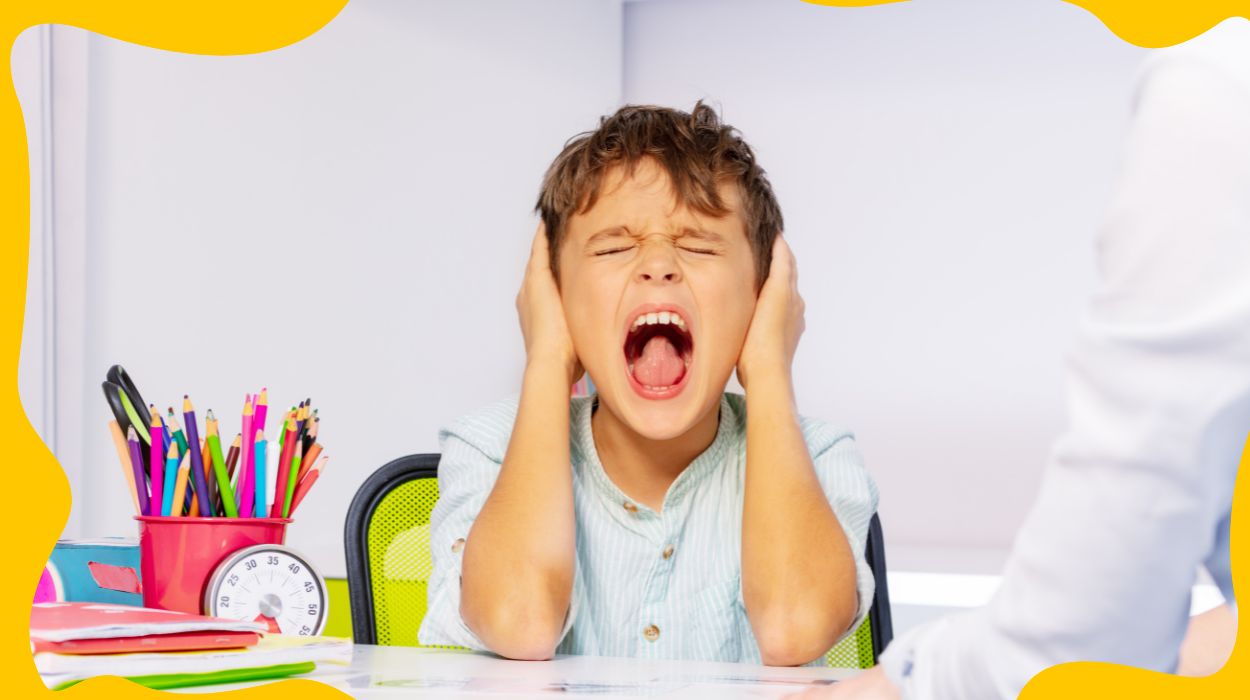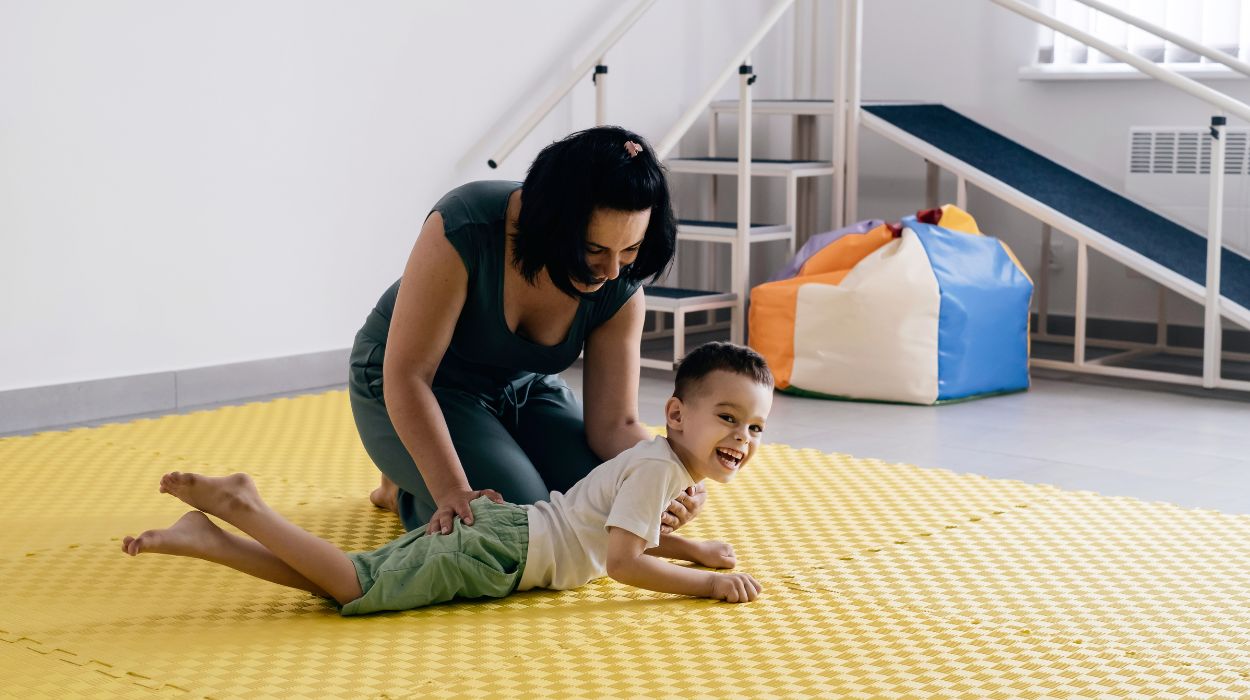How To Calm A Child With Autism: Our 11 Effective Tips

Kids act out sometimes. For younger children in particular, that can mean yelling, crying, or waving their arms. Your kid might even sometimes throw a punch or fall to the ground and scream.
Autistic children face frustration just like other kids, but due to their social deficits and repetitive behaviors, tantrums can become prolonged and difficult to resolve. They may not be able to control their behaviors when they become frustrated or overwhelmed. As a caretaker of a child with Autism Spectrum Disorder (ASD), it can be difficult to know how to help them calm down. Luckily, there are ways to help your autistic child to calm down with more ease.
How to Calm An Autistic Child
Emotional outbursts may be inevitable in any autistic child. With that in mind, putting measures in place ahead of time means you’ll be prepared when an outburst does happen. In this article, we will share with you 11 effective calming strategies to prepare your child and yourself for a future meltdown. These include:
11 Things You Can Do To Calm Down an Autistic Child
Always Have Sensory Tools Handy

Children with autism often experience sensory overload in situations where there is a lot happening. Whether it is a concert with loud music and bright lights, or a dinner-table discussion with a bunch of questions, feeling overwhelmed leads to distress. Difficulty communicating that feeling leads to more distress.
Sensory tools[1] can help with those feelings. Sensory tools are objects that either add or remove sensory stimulation. Some examples are noise-canceling headphones, a weighted blanket, a pop-it as pictured above, or a soft, furry stuffed animal.
These tools are helpful to autistic children because they are soothing to the senses, and they can give your children something else to focus on when they are feeling overwhelmed or distressed.
Establish A Calming Routine
Developing a routine that helps your autistic child calm themselves can be a benefit for both you and them. It can be a guide back to a more even temper in a fairly chaotic moment. There won’t be one thing that works every time, unfortunately. A routine will probably also have to be part of a wider effort to learn social cues and manage feelings.
There are a few classic tricks that can be very helpful. One that is often recommended is counting slowly, distracting yourself. Another tactic might be to have your child hum, which provides its own sort of sensory stimulation.
Sensory tools can be extremely helpful, but it’s a good idea to have some options that don’t rely on extra things you might not have with you in an emergency.
Involve Your Child

It’s not always possible, but it can be helpful to discuss this issue with your child. They might have suggestions on how to help them avoid an autistic meltdown and help them calm down when they are distressed. More insight into how autistic child feels about their experiences is never a bad idea.
Stay Calm and Empathetic
When your kid is crying, it’s easy to get frustrated. Autistic meltdowns are more likely when an autistic child is outside their comfort zone, particularly out in public. People may not understand your child is an autistic person, and it can feel embarrassing when your child acts out.
It’s a tremendously frustrating situation for parents as much as it is for their autistic children. When we become distressed ourselves, we may try to help but end up making it worse.
When trying to help an autistic child, it’s vital that you remain calm. Meltdowns are not attempts to manipulate you.[2] Instead, the child on the autism spectrum has become overstimulated to such an extent that they have to express their distress. They may be looking to you to help them manage their feelings.
Help Them Feel Safe

Autistic meltdowns can sometimes seem like poor behavior. The natural reaction may be to impose discipline, or you may just explain to them what they did wrong. At that moment, however, that sort of reasoning isn’t helpful.
A feeling of safety is something that can definitely help, however. After all, they’re distressed and upset. Feeling safe is always soothing and offers a place to start calming down.
This approach has to be tailored to the individual. Darkness and quiet are often helpful. A weighted blanket is sometimes suggested as it can simulate a sort of body hug.
One thing that can be helpful, particularly in public, is an escape plan. Often it is the location itself that is causing a problem, such as standing in a crowd or being at a movie. Leaving the theater or finding a quiet corner can alleviate sensory overload and help your child calm down.
Keep in mind that you want to work with your autistic child on this aspect. If you can, point out the safer spot and help them make their way there. Autistic children can have problems with physical contact and it can increase distress, so grabbing or even simple touch may not be helpful.
Additionally, try to come down to their level so you don’t loom over them. Speak slowly and at a low volume. Don’t make sudden gestures. Try to be as reassuring as possible.
Reduce Sensory Input
We’ve discussed this a little bit already. Things like sensory tools, and sensory toys, specifically, can be helpful in reducing sensory input. Some are designed to reduce stimulation completely, like noise-canceling headphones. Others give the child something else to focus on, like a fuzzy toy.
It can help to think in terms of the five classic senses. Reduce sight stimulation by lowering the lights or finding a less visually stimulating location. Noise-canceling headphones can help, though music might also be helpful. How to offer this sort of help will most likely depend on the situation’s specifics and your child’s preferences.
There are senses other than the traditional five, of course. One that is of particular concern to autistic children is interoceptive awareness.[3] That is the awareness of your body’s condition and things like hunger, itchiness, pain, and body temperature. Autistic children may have a more difficult time with this sort of awareness, which can lead to another sort of sensory overload.
In some ways, that sort of overstimulation is the most difficult to spot. Autistic children have trouble communicating and are often unable to express how they are having problems. This is another area where some preparation might be helpful. You can help an autistic child be more aware of what their body is trying to tell them. That way they can address those needs before it becomes distressing.
Communicate with Bystanders
Outbursts in public can often seem like the worst of the lot, a trial for both you and your child. Of course, being in public can often be more difficult for a child with autism. As a result, outbursts may be more common in public, or may even be more severe.
On the other hand, they might just seem worse because of the potential for an audience. Meltdowns are bad enough when you’re at home. When things kick off in public, as they so often do, there’s the added pressure of a crowd on top of dealing with a distressed child.
Most people will be sympathetic, perhaps more than you might think. Additionally, autism is not as rare a diagnosis as it once was and there is support out there.[4]
Ushers at a movie theater might be able to direct you to a family room that’s quieter and out of public view. Bystanders in a crowd might be able to help clear a path out.
You don’t have to explain that your child is on the autism spectrum or any of the other details of your situation. Seeing a child in distress is usually enough to lead people to help.
Work on Coping Strategies
Just as there are some things you can do to prepare before the inevitable blow-ups, there are often some after-action measures you can take to make things easier next time. Behavioral therapy is a common treatment for children with autism spectrum disorder. It uses a number of methods to teach helpful habits and skills, as well as a number of coping strategies for stressful situations.
There are other varieties of coping strategies that can help your autistic child. Many may be particular to a child, but there are a few that are common.
Practice Meditation Techniques

Meditation is a word that covers a lot of territories. Not too long ago, the word brought to mind an older man, probably from East Asia, sitting cross-legged and looking serene. As time has gone on, our understanding has increased. We’ve also found ways to apply that understanding in therapeutic ways that can help people learn to cope.
In its broadest sense, meditation is a way of practicing focus. It’s a discipline that helps you put your attention where you want. That discipline can be used in lots of ways therapeutically, and new ways are still being explored.
The most obvious way is that it can help your child calm down. Just spending a few moments sitting quietly can be a great habit. It also provides an opportunity to practice being calm, learning what it feels like, and how to find your way there.
Meditation can also be helpful for managing sensory overload. It’s one way of helping them with interoceptive awareness, which we discussed earlier. Meditative methods can help you learn to pay better attention to your senses and what your body is telling you.
Establish Routines and Schedules
Autism meltdowns can come in many different forms and a sensory overload is just one. Repetitive behavior is a common part of autism and can often be soothing. That tendency can be used in a healthy way by helping an autistic child develop routines and a schedule.
Surprises and changes are often another source of distress. By creating routines and a schedule, you’re reducing the chances that your child will face surprises or need to make many sudden changes. It’s much easier to stay calm when you know what to expect.
Get Some Exercise

There’s really no doubt that physical activity is helpful for mental well-being.[5] It releases all sorts of feel-good chemicals in the brain and also keeps you physically well. Getting your autistic child up and moving on a regular basis can be a great way of coping with stressful situations.
Activity can mean a lot of things. You don’t necessarily have to sign them up for weightlifting classes or the track team. However, all that really matters is moving around and having a good time. It could be dancing, bowling, or just taking a short walk.
As with anything else, if you find something that catches your child’s interest, they’re much more likely to stick with and enjoy it.
Recognize Early Warning Signs
Though it may often seem like it, these outbursts rarely come out of nowhere. More than likely, problems are the result of multiple factors culminating in that straw that breaks the camel’s back. Your child reaches the limit of what they can handle and may have no choice but to act out.
An ounce of prevention is worth a pound of cure, as they say. It won’t be every time, but if you can spot the warning signs and help your child calm down, you might be able to avoid an outburst.
Most parents already know some of their child’s warning signs. There are a few that are shared by many autistic children. They can include:
- Screeching or noise-making
- Running away
- Self-stimulation, such as repetitive motions
- Covering ears or eyes
- Refusal to engage with people around them
- Frustration
Those are big red flags, while subtler signs may vary between children.
When you’re able to spot a building outburst and want to derail it, you can use most of the ideas we’ve already covered. Things like finding a safe space and providing sensory tools are both good ways to keep your child from getting overloaded.
Inevitably, there are situations where that might not be an option. That’s a tough spot and really the solution is to get out of it as soon as possible. However, there’s one simple trick (no kidding) that may be able to help: Distraction.
You may have seen people snapping a rubber band to help manage anxiety or anger issues. It’s easy to get into a spiral where anxiety or some other sort of distress feeds into itself, leading to an outburst. If you can distract your child, breaking the spiral, that may be enough to prevent them from being overstimulated. In the same way that a snapping rubber band can startle someone out of a black mood, a gentler form of distraction can short-circuit building distress.
The rubber band may not be a good idea for your autistic child. However, the distraction can be anything that might catch their attention. If you’ve already worked up and practiced calming strategies with your child, this would be the perfect moment to use them.
Conclusion
Working with an autistic child may present particular problems since they lose control when they have autism meltdowns. Remember that those problems aren’t insurmountable. It may take a lot of patience and hard work on everyone’s part. It is possible, however, to help a child with autism calm down and regain control of themselves.
+ 5 sources
Health Canal avoids using tertiary references. We have strict sourcing guidelines and rely on peer-reviewed studies, academic researches from medical associations and institutions. To ensure the accuracy of articles in Health Canal, you can read more about the editorial process here
- Autism Speaks. (2023). What is a sensory toy and how do they help? | Autism Speaks. [online] Available at: https://www.autismspeaks.org/blog/what-sensory-toy-and-how-do-they-help [Accessed 23 Jun. 2023].
- AANE (2016). How to Handle Meltdowns – The Asperger / Autism Network (AANE). [online] The Asperger / Autism Network (AANE). Available at: https://www.aane.org/how-to-handle-meltdowns/ [Accessed 23 Jun. 2023].
- Bennie, M. (2020). Calming Strategies to Support an Autistic Person – Autism Awareness. [online] Autism Awareness. Available at: https://autismawarenesscentre.com/calming-strategies-to-support-a-person-with-autism/ [Accessed 23 Jun. 2023].
- Autism Speaks. (2023). Parents of child with autism seek help with public meltdowns | Autism Speaks. [online] Available at: https://www.autismspeaks.org/expert-opinion/parents-child-autism-seek-help-public-meltdowns [Accessed 23 Jun. 2023].
- Sharma, A., Vishal Madaan and Petty, F. (2006). Exercise for Mental Health. [online] 08(02), pp.106–106. doi:https://doi.org/10.4088/pcc.v08n0208a.



